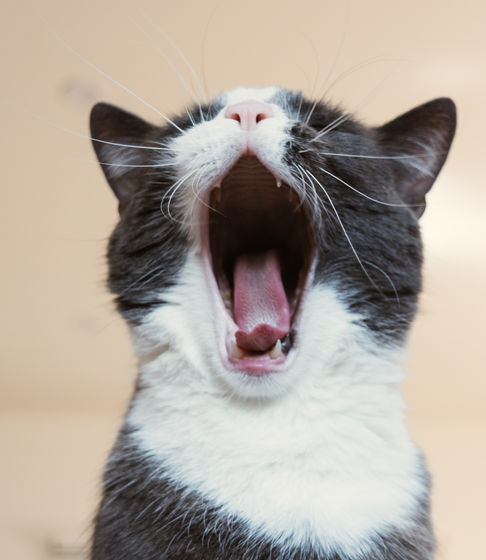The mechanism by which cats purr is finally revealed

Cats purr when they are relaxing, but the exact mechanism behind this purr has not been clarified. Meanwhile, a new paper published in the academic journal
Domestic cat larynges can produce purring frequencies without neural input: Current Biology
https://www.cell.com/current-biology/fulltext/S0960-9822(23)01230-7

We now know how cats purr—why they purr is still up for debate | Ars Technica
https://arstechnica.com/science/2023/10/we-now-know-how-cats-purr-why-they-purr-is-still-up-for-debate/
It is well known that cats purr, but other animals such as raccoons, mongooses, kangaroos, badgers, rabbits, and guinea pigs also make purring sounds. Felines can be broadly divided into the Felinae family , which purrs, and the Panthera family , which barks instead of purring. There are no cats that can both purr and bark, and the latter category includes lions, tigers, jaguars, leopards, etc.
A team of Australian scientists investigated the structure of the feline pharynx. This study revealed that the ability of cats to roar is due to incomplete ossification of the hyoid bone in the pharynx. In contrast, felines capable of purring have fully ossified hyoid bones.

When a cat purrs, it emits 20 to 30 vibrations per second, and the maximum frequency of the purr is said to be around 150Hz. In general, larger animals have longer vocal cords and therefore emit lower frequency sounds, whereas cats have smaller bodies and shorter vocal cords, so based on their anatomy, It seems that it should emit a higher frequency. Nevertheless, the researchers noted that the purring sounds made by cats are low-frequency.
The gurgling sound made by cats is explained by
The most widely believed theory is the active muscle contraction (AMC) theory, which states that the purring sounds made by cats are caused by muscle contraction caused by nerves. However, this AMC theory contradicts the myoelastic aerodynamics (MEAD) theory, which states that most mammals produce sounds through self-sustaining vibrations of tissues within the pharynx. Furthermore, there was almost no empirical evidence to prove the AMC theory.

Therefore, in order to verify whether the AMC theory is correct, the research team removed the pharynxes of eight cats that had been euthanized due to terminal illness. The excised pharynx was immediately flash-frozen in liquid nitrogen, stored at -20°C, and slowly thawed to room temperature the night before the experiment. Each pharynx was cleaned, photographed, and passed through superheated air with 100% humidity.
The pharynx was then fixed using Lego blocks and a 3D-printed plastic mount, and one mini-electrode was attached to each side of the thyroid cartilage to record glottogram signals. When the magnetic valve used to supply air is gradually opened and closed, the air is pumped in, controlling the subglottic pressure, and causing the attached pharynx to vibrate. One of the eight pharyngeal samples was subjected to histological analysis, and the other was CT scanned.

Assuming that all adjacent muscles had been removed when the pharynx was removed, the research team was able to reproduce the purring sound by pumping air through all eight pharynx sections without muscle contraction. Succeeded. The researchers also find that connective tissue embedded in the vocal cords plays a role in lowering the frequency of cats' purrs. In other words, it has become clear that cats purr using the same mechanism based on MEAD theory that other mammals make vocalizations.
The research team says that this discovery does not prove that the AMC theory is completely wrong, saying, ``It is simply that the AMC theory needs to be revised.A combination of two theories (AMC theory and MEAD theory). As always, further research is needed, but MEAD theory-based vocal fold vibration allows cats to emit low-frequency purrs even in the absence of active muscle contraction neural input. 'It became clear that it could make a rumbling sound.'
There is still debate as to why cats purr. Mother cats typically purr while nursing or to reassure their kittens. Therefore, it is thought that purring may release hormones in the kitten's brain that help it relax, relieve pain, and facilitate healing.
In contrast, it has been revealed that the purring sounds that cats make when asking humans for food contain high-frequency elements that are not included in general cat purring sounds. People who listen to this inviting rumbling sound consistently do not find it unpleasant and rate it as highly urgent.
Related Posts:







